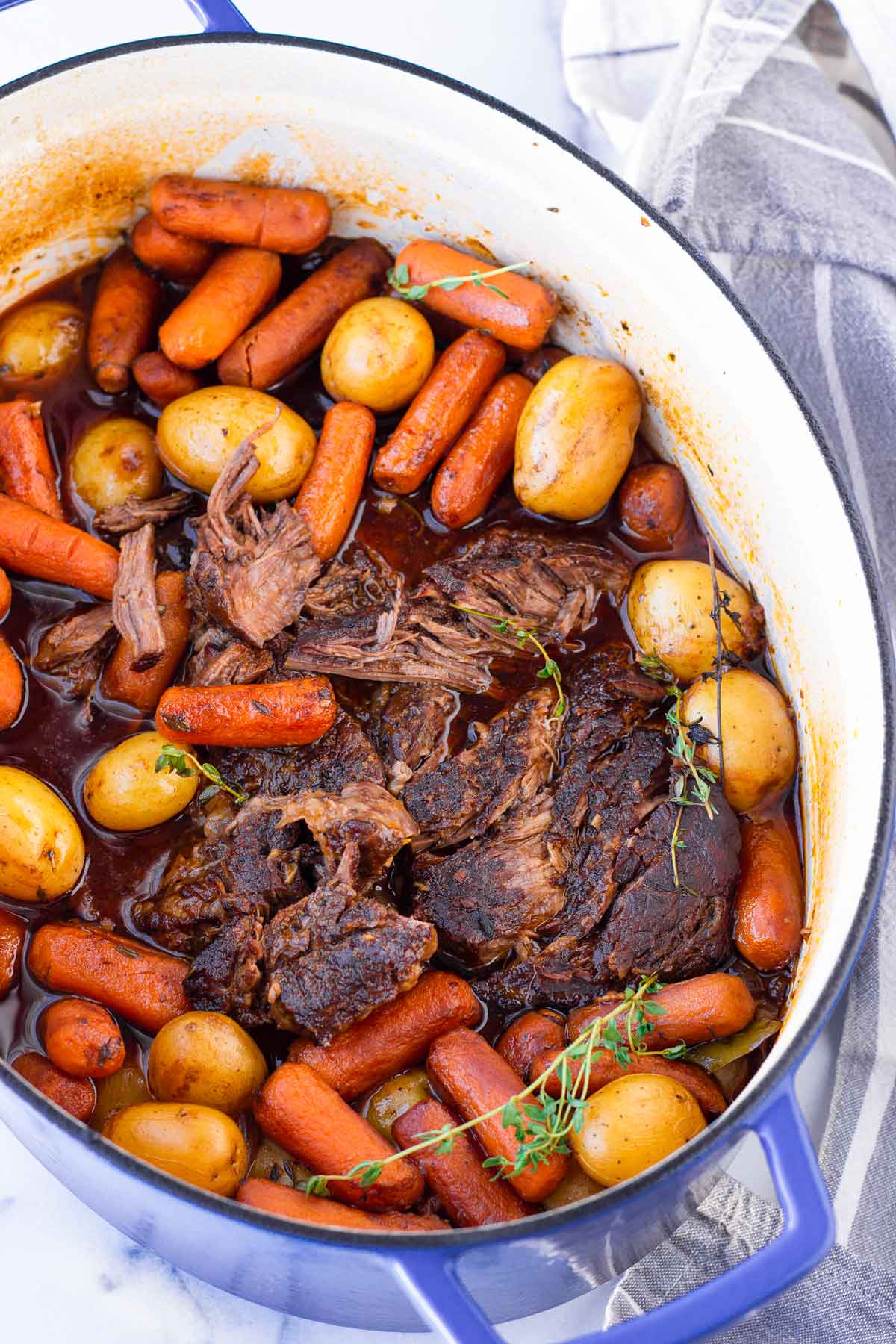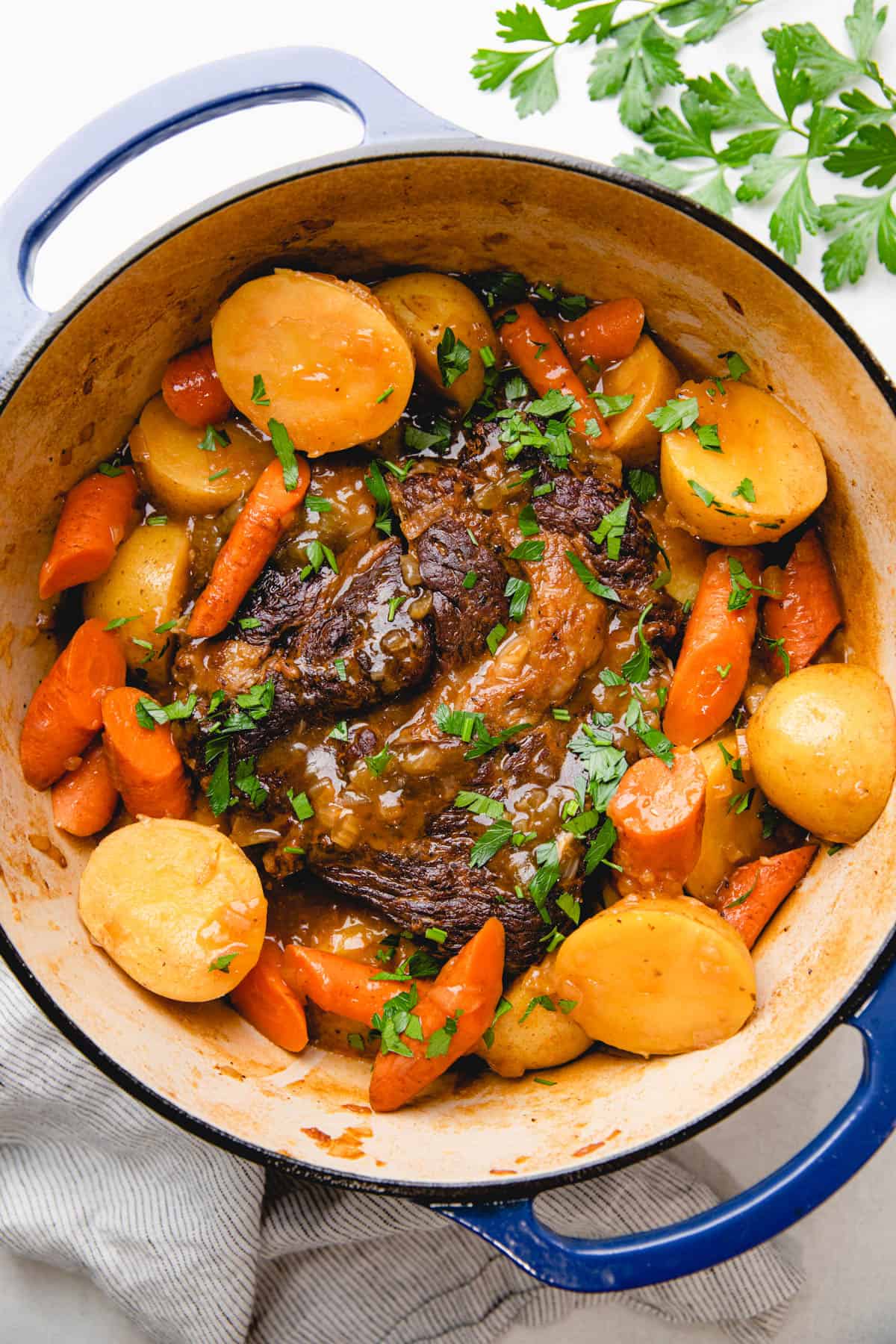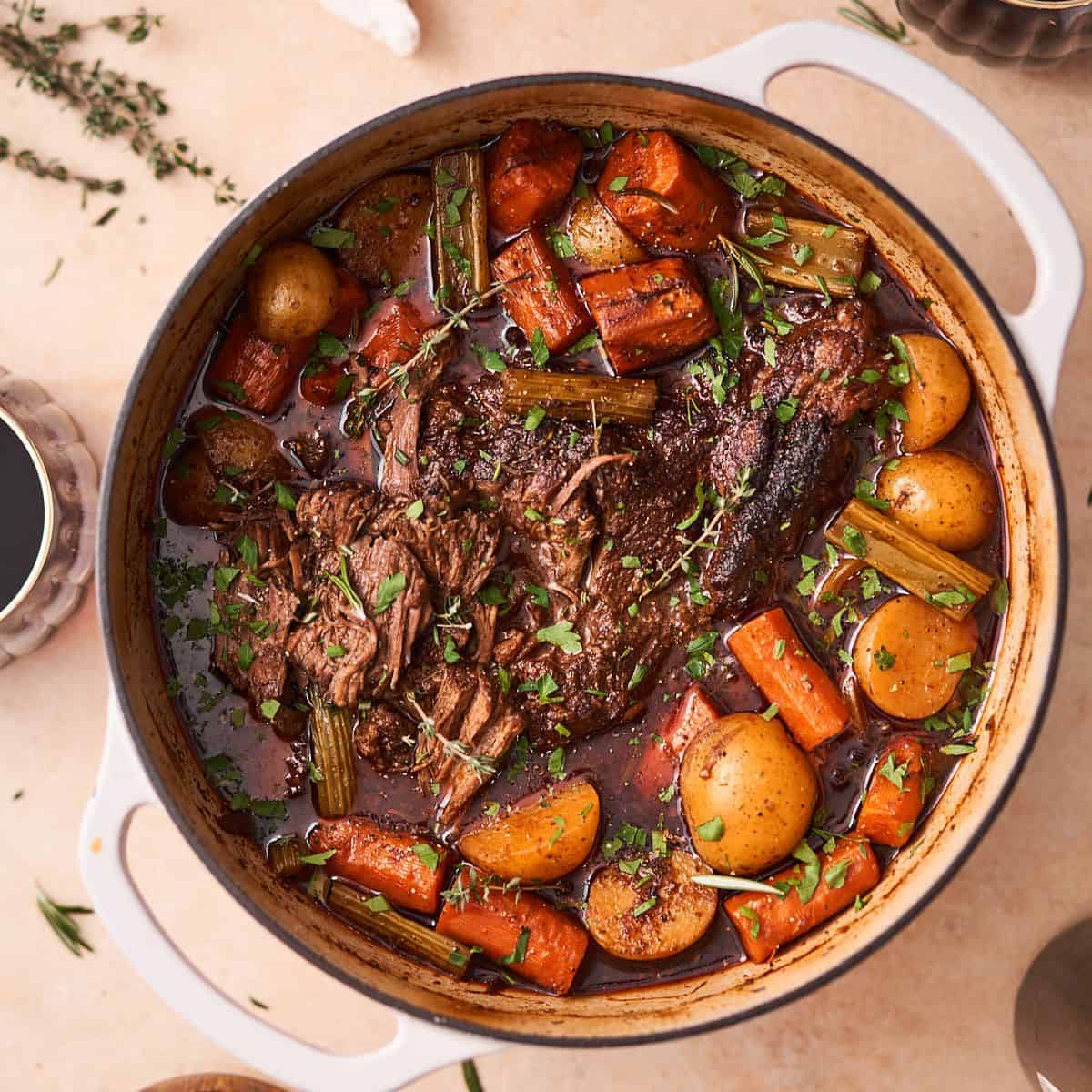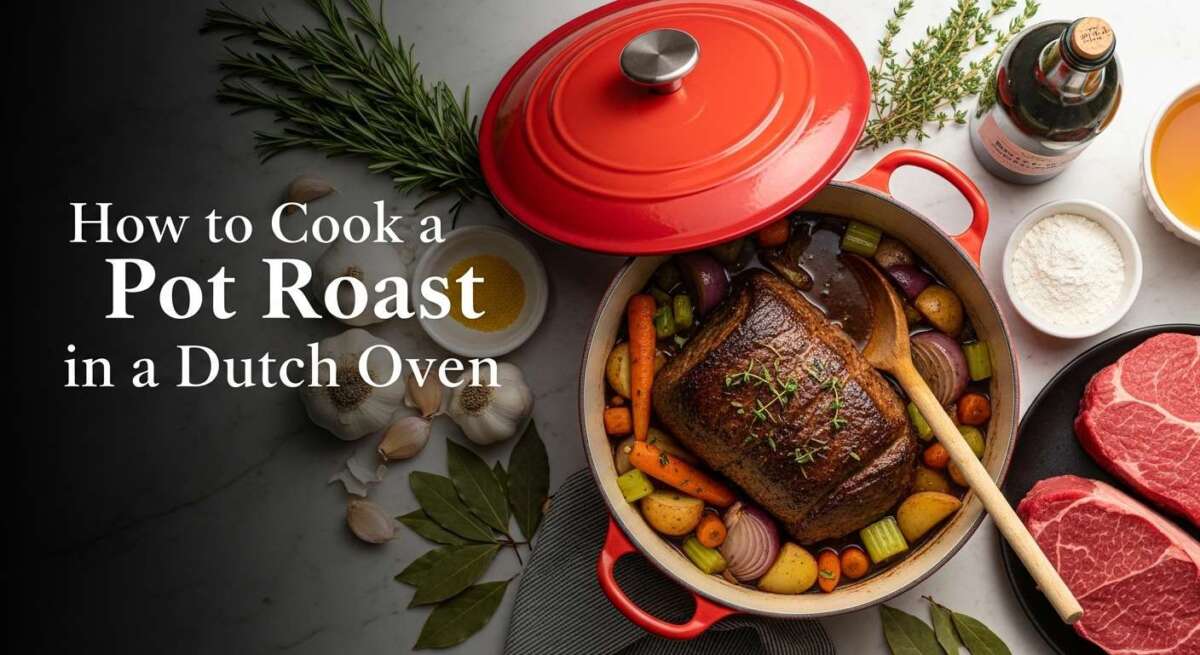Imagine the aroma of a savory pot roast wafting through your kitchen, making your mouth water in anticipation. Cooking a perfect pot roast in a Dutch oven is simpler than you might think, and it’s a skill you can easily master.
Whether you’re planning a cozy family dinner or impressing guests with your culinary prowess, this method promises tender, flavorful results every time. But why a Dutch oven, you ask? It’s not just about tradition. The unique design of this classic cookware ensures even heat distribution, bringing out the best in your ingredients.
As you follow along, you’ll discover tips and tricks that transform an ordinary meal into a memorable dining experience. Ready to unlock the secrets of a melt-in-your-mouth pot roast? Let’s dive right in.
Choosing The Right Cut Of Meat
Selecting the perfect cut of meat ensures a tender pot roast. Opt for chuck roast, which cooks well in a Dutch oven. Its marbling adds flavor, while slow cooking keeps it juicy and soft.
Choosing the right cut of meat is crucial for a perfect pot roast in a Dutch oven. The flavor and tenderness of your dish largely depend on this choice. A well-selected cut can transform your pot roast into a melt-in-your-mouth experience.
Understanding Different Cuts
When I first tried making pot roast, I picked up the wrong cut, and the result was less than satisfying. Choosing between chuck roast, brisket, or round can be daunting. Each has its unique characteristics, and knowing them helps you decide. Chuck roast is a favorite for its marbling. These fat streaks keep the meat juicy and flavorful. Brisket, on the other hand, offers a rich taste but needs slow cooking to tenderize. Round cut is leaner, requiring careful attention to keep it from drying out.
Making The Right Choice
Consider the occasion and your taste preference. If you love a hearty, robust flavor, go for chuck roast. Its marbling makes it forgiving for beginners. For a special dinner, brisket adds depth and a unique taste that impresses guests. It demands patience but rewards you with rich texture. If you’re health-conscious, round cut is lean but needs a marinade or sauce to enhance its flavor. A pot roast is versatile, letting you experiment with flavors and techniques.
Local Availability And Budget
Local availability can influence your choice. Visit your butcher and ask for advice on the freshest cuts. They often have insights into what suits your dish best. Budget plays a role too. Chuck roast is typically more affordable, making it a great choice for family meals. Brisket might be pricier but worth it for special occasions.
Questions To Consider
What flavors do you want in your pot roast? Do you prefer juicy or lean meat? Are you cooking for a regular meal or a celebration? Choosing the right cut means understanding your needs and the dish’s purpose. Each choice leads to different experiences and flavors. Which one aligns with your culinary goals?
Essential Ingredients
Crafting a delicious pot roast in a Dutch oven begins with selecting fresh beef, hearty vegetables, and savory spices. Combine carrots, potatoes, and onions with garlic, thyme, and rosemary for rich flavors. Brown the beef, add broth, and let it simmer to create a tender, mouthwatering dish.
Cooking a pot roast in a Dutch oven can be a delightful experience. The secret lies in choosing the right ingredients. Each component plays a crucial role in flavor and texture. Let’s explore the essential ingredients needed for a delicious pot roast.
Meat Selection
The meat is the star of your pot roast. Choose a cut with marbling. Chuck roast is a popular choice. It becomes tender and flavorful. The marbling in the beef adds richness. Make sure the cut is around 3 to 4 pounds. This size fits well in a Dutch oven.
Vegetables And Herbs
Vegetables add depth and nutrition. Carrots, potatoes, and onions are must-haves. Cut them into large chunks. They should hold shape during cooking. Fresh herbs like thyme and rosemary enhance flavor. Add a bay leaf for an earthy note.
Seasonings And Spices
Seasonings bring out the best in your roast. Salt and pepper are essential. Garlic powder adds a savory touch. Paprika offers a mild heat. Use these to coat the meat evenly. They seep into the meat while it cooks.
Liquids And Broths
Liquids help keep the roast moist. Beef broth is a classic choice. It deepens the meat’s flavor. Red wine can add richness. Pour enough to cover the bottom of the pot. This prevents burning and ensures even cooking.
Preparing The Dutch Oven
Cooking a pot roast in a Dutch oven creates a delicious, tender meal. Preparing your Dutch oven correctly is crucial for achieving the best results. This section guides you through cleaning, preheating, and choosing the right oil. Let’s dive into the steps that ensure your pot roast turns out perfect.
Cleaning And Preheating
Begin with a clean Dutch oven. Use warm water and mild soap to wash it. Scrub gently with a soft sponge. Avoid abrasive materials that could damage the surface. Rinse thoroughly and dry it with a clean towel.
Preheat your Dutch oven on the stove. Set the heat to medium. This ensures even cooking. Let it heat for about five minutes. A well-preheated Dutch oven helps brown the meat nicely.
Using The Right Oil
Choose oils with high smoke points. Olive oil and canola oil are great options. They withstand high heat without burning. Pour a small amount into the Dutch oven. Swirl it to coat the bottom evenly. This prevents sticking and enhances flavor. Proper oil choice leads to a perfectly seared pot roast.
Searing The Meat
Searing the meat creates a flavorful crust essential for a delicious pot roast in a Dutch oven. This initial step enhances taste by locking in juices before slow cooking. Ensure the meat is dry and the oven hot for perfect sear.
Cooking a pot roast in a Dutch oven is a delightful experience, with searing the meat being a crucial step that sets the foundation for flavors. Searing locks in juices, creating a tasty crust that elevates your dish. It’s more than just browning; it’s about building layers of taste. Picture the aroma filling your kitchen as the meat sizzles in the hot pan—pure magic! But how do you achieve that perfect sear every time? Let’s dive into the techniques and timing that make it happen.
Achieving The Perfect Sear
To get that golden crust, start by patting your meat dry with paper towels. Moisture is the enemy of a good sear. Season generously with salt and pepper; these simple ingredients enhance flavor and help form a crust. Preheat your Dutch oven over medium-high heat. You want it hot enough to make the oil shimmer but not smoke. A common mistake is overcrowding the pan.
Ensure there’s space around each piece of meat. This allows even cooking and prevents steaming. Consider using a mix of oils, like olive oil with a bit of butter. The butter adds flavor while the oil raises the smoke point. As the meat hits the pan, listen for the sizzle—that’s the sound of success.
Timing And Techniques
Timing is everything. Sear each side for about 3-4 minutes. Resist the urge to move the meat around; let it sit undisturbed. This patience rewards you with a beautiful crust. Use tongs to flip the meat. If it sticks, give it a bit more time. Meat releases naturally when it’s ready. It’s the Dutch oven’s way of telling you, “I’m perfect now.” After searing, let the meat rest on a plate.
This pause allows juices to redistribute. Have you ever noticed how some roasts taste dry? Searing followed by resting prevents this. What’s your favorite searing tip? Maybe you’ve discovered a unique seasoning mix. Share your ideas in the comments! Cooking a pot roast doesn’t have to be intimidating. With a few simple techniques, you can master the art of searing, creating a dish that’s bursting with flavor. Try it, and watch your family rave about dinner tonight.
Building Layers Of Flavor
Building layers of flavor in a pot roast elevates the dish. The rich taste comes from careful ingredient choices. Slow cooking in a Dutch oven creates depth. Each step adds complexity and delight.
Adding Vegetables
Start with carrots and onions. They bring sweetness and color. Celery adds crunch and depth. Chop them into large pieces. They hold up well during cooking. Enhance with potatoes for heartiness. Their starch thickens the sauce.
Incorporating Herbs And Spices
Herbs make the flavor shine. Thyme is earthy and aromatic. Rosemary adds a hint of pine. Bay leaves offer subtle bitterness. Use garlic for its bold taste. Pepper adds a mild heat. Salt balances the flavors.

Credit: cookingformysoul.com
Slow Cooking Process
The slow cooking process makes the pot roast tender and flavorful. A Dutch oven helps achieve this by distributing heat evenly. It seals in moisture, allowing flavors to develop over time. This method requires patience but rewards with delicious results.
Setting The Temperature
Begin by preheating your oven to a low temperature. Around 300°F (150°C) is ideal for slow cooking. This low heat ensures the meat cooks gently. The Dutch oven’s heavy lid traps steam, keeping the roast moist. Proper temperature setting is crucial for tenderness.
Monitoring Cooking Time
Cooking time varies based on meat size and cut. Generally, a 3-pound roast takes 3-4 hours. Check the roast every hour to monitor progress. Use a fork to test tenderness. If it pierces easily, the roast is done. Overcooking can dry out the meat, so stay attentive.
Checking For Doneness
Ensure the pot roast is tender by checking for doneness with a fork. The meat should easily pull apart. If it resists, cook longer until perfect tenderness is achieved.
Checking for doneness is a crucial step in cooking a perfect pot roast in a Dutch oven. It ensures that your meal is not only safe to eat but also tender and flavorful. You’ve patiently waited for the magic to happen in your Dutch oven, and now it’s time to make sure your pot roast is just right.
Temperature Guidelines
A meat thermometer is your best friend when checking for doneness. Insert it into the thickest part of the roast, avoiding bones and fat. Aim for an internal temperature of around 145°F (63°C) for medium-rare or 160°F (71°C) for medium. Remember that the roast will continue to cook slightly after you remove it from the oven. Allow it to rest for a few minutes to reach the perfect temperature.
Visual And Texture Cues
Visual cues are just as important as temperature. The pot roast should have a rich, deep brown color. If it’s pale, it might need more time in the oven. Check the texture by gently pressing down on the meat with a fork. A tender pot roast will yield easily under pressure. If it’s still tough, give it a bit more time to cook. Do you enjoy that melt-in-your-mouth texture? If so, make sure the meat easily falls apart when you try to pull it with a fork. That’s when you know it’s ready to serve and impress your guests. Cooking a pot roast is a blend of science and art. Your senses are just as important as the tools you use. Have you ever relied on your instincts to judge doneness? Give it a try and see how your cooking skills flourish.
Resting And Serving
Cook the pot roast in a Dutch oven until tender. Let it rest for juicy meat. Then, slice and serve with vegetables for a hearty meal.
Cooking a pot roast in a Dutch oven is a rewarding experience, blending flavors and aromas into a comforting meal. Once the roast is done, the journey doesn’t end there. Resting and serving your masterpiece play crucial roles in elevating the dining experience. It’s often the simple touches that make a dish memorable.
Allowing The Meat To Rest
Once you remove the pot roast from the Dutch oven, resist the urge to dive right in. Allowing the meat to rest is essential. This pause lets the juices redistribute throughout the roast, ensuring each bite is moist and flavorful. A good rule of thumb is to rest the meat for about 15 to 20 minutes. Use this time to prepare the table or whip up a quick salad. You’ll find that your patience pays off with a more tender and delicious result. Have you ever cut into a roast immediately, only to watch the juices run away? Letting it rest prevents this tragedy. It’s a small investment of time with a big payoff.
Carving Techniques
Carving your pot roast can be an art form. Choose a sharp knife to make clean, smooth slices. This not only looks more appealing but also makes the meat easier to enjoy. Consider the grain of the meat. Cutting against the grain will result in more tender slices. This technique breaks down the muscle fibers, making each bite softer. How do you usually slice your roast? Experiment with different angles to find what works best for you. Each cut can bring out unique textures and flavors.
Remember, presentation matters. Arrange your slices neatly on a platter. It turns your meal into a visual feast, inviting everyone to dig in. Resting and serving are not just about technique; they are about enhancing the entire experience. These steps create a sense of anticipation, making the meal more satisfying and memorable. What’s your favorite way to serve a pot roast?
Tips For Perfect Pot Roast
Cooking a pot roast in a Dutch oven brings out rich flavors. Start by browning the meat on all sides. Then, add vegetables and broth, cover tightly, and let it simmer slowly for tender, juicy results.
Cooking the perfect pot roast in a Dutch oven is an art that combines technique, patience, and a touch of creativity. While the process may seem straightforward, there are several tips that can elevate your dish from good to unforgettable. Whether you’re a seasoned chef or a kitchen novice, these insights will guide you in crafting a pot roast that leaves your guests craving more.
Avoiding Common Mistakes
Avoiding common pitfalls is crucial for a successful pot roast. One frequent mistake is not searing the meat properly. This step is vital because it locks in the juices and adds depth to the flavor. Make sure your Dutch oven is hot enough before adding the meat. You should hear a satisfying sizzle as the meat hits the surface. Another oversight is rushing the cooking process. A pot roast thrives on slow and steady cooking. If you try to speed things up, you risk ending up with tough meat. Allow the roast to cook at a low temperature for several hours. This patience results in tender, succulent meat that melts in your mouth.
Enhancing Flavor
Enhancing the flavor of your pot roast is all about layering. Start with a robust marinade or rub. Consider using garlic, rosemary, and thyme to infuse the meat with aromatic goodness. Have you tried adding a splash of red wine or balsamic vinegar? It can elevate the dish to new heights. Vegetables play a crucial role in flavor enhancement. Choose hearty options like carrots, onions, and potatoes. They absorb the juices and spices, adding complexity to each bite. You can even sauté them briefly before adding them to the pot for an extra burst of flavor. Finally, think about the broth or liquid you use.
Opt for beef stock or a combination of beef and chicken broth. This not only keeps the roast moist but also enriches the overall taste. Experiment with different herbs and spices in the liquid to suit your personal preference. Imagine the satisfaction when your pot roast becomes the highlight of a family gathering or dinner party. What secrets do you have for perfecting your pot roast in a Dutch oven? Share your insights and let’s create culinary magic together.

Credit: veronikaskitchen.com

Credit: afullliving.com
Frequently Asked Questions
How Long To Cook Pot Roast In A Dutch Oven?
Cooking a pot roast in a Dutch oven typically takes about 3 to 4 hours. Start by searing the meat, then add vegetables and broth. Simmer it on low heat. The roast is done when it’s tender and easy to pull apart with a fork.
What Is The Best Cut For Pot Roast?
The best cuts for pot roast are chuck, brisket, or round. These cuts become tender with slow cooking. They have enough marbling to keep the meat moist. Choose a cut that fits well in your Dutch oven for even cooking.
Do I Need To Brown Pot Roast First?
Yes, browning the pot roast before cooking enhances flavor. Searing the meat creates a caramelized surface. This process adds depth and richness to the dish. It’s an important step for a flavorful pot roast in a Dutch oven.
Can I Add Vegetables To My Pot Roast?
Absolutely, adding vegetables like carrots, potatoes, and onions enhances flavor. Add them halfway through the cooking process. This ensures they cook perfectly without becoming mushy. Vegetables also soak up the delicious juices, adding to the dish’s richness.
Conclusion
Cooking pot roast in a Dutch oven is simple and rewarding. The process enhances flavors, making the meat tender and juicy. The Dutch oven’s even heat distribution is key. With basic ingredients, you create a hearty meal. Follow the steps, and you’ll impress family and friends.
It’s perfect for any occasion, providing comfort and satisfaction. Enjoy experimenting with spices for a personal touch. Cooking this way connects you to tradition. Experience the joy of a homemade feast. Keep the recipe handy for future gatherings. You’ll appreciate the simplicity and delicious results every time.
Happy cooking!


Leave a Reply